Details, details
What speaks to you when you look at art? Is it the medium? Is it the design? Is it shape or ![Chihuly_at_Kew_Gardens_043[1] (640x480)](https://blog.itscactus.com/wp-content/uploads/2012/09/Chihuly_at_Kew_Gardens_0431-640x480-150x150.jpg)
![the-girl-with-a-pearl-earring-johannes-vermeer-t14769[1] (354x500)](https://blog.itscactus.com/wp-content/uploads/2012/09/the-girl-with-a-pearl-earring-johannes-vermeer-t147691-354x500-150x150.jpg) color or pattern? All of those elements play their part, to be sure. Still, my guess is that when you look at a piece of art, whether it’s a 17th century painting by Jan Vermeer, or a contemporary piece of glasswork by Dale Chihuly, or a piece of Haitian folk art by Jean Eugene Remy, it is the details that draw you in.
color or pattern? All of those elements play their part, to be sure. Still, my guess is that when you look at a piece of art, whether it’s a 17th century painting by Jan Vermeer, or a contemporary piece of glasswork by Dale Chihuly, or a piece of Haitian folk art by Jean Eugene Remy, it is the details that draw you in.
Take for example this one-of-a-kind piece. Jean Eugene has whimsically imagined this bus going to market. Unencumbered by proportion, the round bus goes bumping through the countryside, dodging low-flying birds. The youth riding on top points the way as he reclines against a box and a 3-D basket containing a chicken and various produce. The dimensional ![ht01387[1]](https://blog.itscactus.com/wp-content/uploads/2012/09/ht0138711.jpg) effect of the basket is achieved by cutting the contents backwards as a side piece and then bending the metal tightly behind the slitted, concave basket. A little bit more time spent in execution, but the result is good visual impact. A fine detail
effect of the basket is achieved by cutting the contents backwards as a side piece and then bending the metal tightly behind the slitted, concave basket. A little bit more time spent in execution, but the result is good visual impact. A fine detail
Look again. Notice that all of the passengers vary somewhat. Different hats, different clothing, different fullness in the face, longer hair, shorter hair. Individual characteristics that give the riders character. Clones don’t ride the bus, people do. Details.
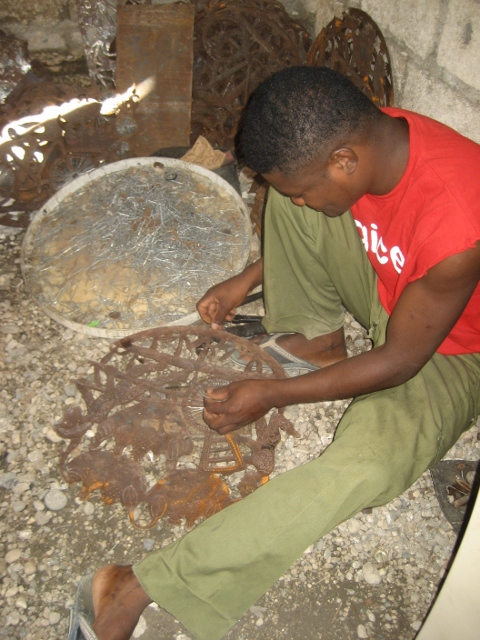 And the bus itself. Notice how small caps have been hand-riveted on the front end as headlights. Clever. The wheels, however, are the coup d’grace. They revisit vintage wire wheel hubcaps on Corvettes and Cadillacs, 1968-1982. (Yes, I looked it up, and by-the-way, you can find them on ebay for about $1250, if you’re in the market.) Jean Eugene innovatively uses spout caps and rivets and wire hooks, which are bent one at a time to create each spoke. Fifty-seven in the back and sixty-three in the front. Talk about detail!
And the bus itself. Notice how small caps have been hand-riveted on the front end as headlights. Clever. The wheels, however, are the coup d’grace. They revisit vintage wire wheel hubcaps on Corvettes and Cadillacs, 1968-1982. (Yes, I looked it up, and by-the-way, you can find them on ebay for about $1250, if you’re in the market.) Jean Eugene innovatively uses spout caps and rivets and wire hooks, which are bent one at a time to create each spoke. Fifty-seven in the back and sixty-three in the front. Talk about detail!
This kind of craftsmanship is not unique to one artist alone, though Jean Eugene does raise the bar. Bicycle chain, metal tubes, coins, spikes and more have been utilized with good effect as design elements in Haitian metal sculpture across the board. Next time you look, really look. The more you see, the more you will appreciate. It’s in the details.

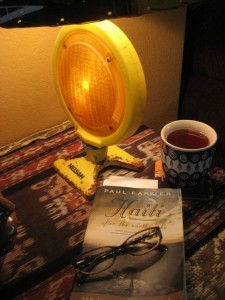 Book report time! Anyone? Ok, I’ll go first. I’m reading a new book by Paul Farmer, UN Deputy Special Envoy for Haiti and Chair of the Department of Global Health and Social Medicine at Harvard Medical School. In 1987, Dr. Farmer, along with several colleagues, founded Partners in Health, an organization dedicated to serving the health care needs of the poorest of the poor. He has worked tirelessly as an advocate for health services as a basic human right and has actively promoted and provided health care in Haiti for decades. His latest book, “Haiti after the Earthquake” gives a superb account of the situation in pre-quake Haiti, the cataclysmic event itself, and the aftermath. Most valuably, Dr. Farmer gives a forthright assessment of what went right and what has failed in the international attempt to help Haiti “build back better.”
Book report time! Anyone? Ok, I’ll go first. I’m reading a new book by Paul Farmer, UN Deputy Special Envoy for Haiti and Chair of the Department of Global Health and Social Medicine at Harvard Medical School. In 1987, Dr. Farmer, along with several colleagues, founded Partners in Health, an organization dedicated to serving the health care needs of the poorest of the poor. He has worked tirelessly as an advocate for health services as a basic human right and has actively promoted and provided health care in Haiti for decades. His latest book, “Haiti after the Earthquake” gives a superb account of the situation in pre-quake Haiti, the cataclysmic event itself, and the aftermath. Most valuably, Dr. Farmer gives a forthright assessment of what went right and what has failed in the international attempt to help Haiti “build back better.”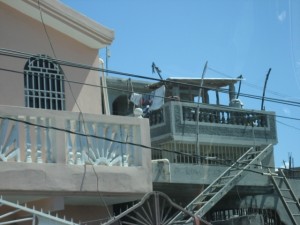
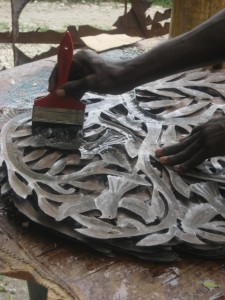 People who buy metal sculptures for the first time often ask: “Is there any care and upkeep involved with this?” Reasonable to wonder, heaven knows. We advertise that they are perfectly suitable indoors and out, but it’s obvious to anyone that’s left their bicycle out in the rain or forgotten garden tools by the sprinkler head that metal will, of course rust. Surface scratching can also occur, for instance if you are storing or stacking pieces. However, neither rust nor scratches are anything that a little clear coat application can’t correct with good result.
People who buy metal sculptures for the first time often ask: “Is there any care and upkeep involved with this?” Reasonable to wonder, heaven knows. We advertise that they are perfectly suitable indoors and out, but it’s obvious to anyone that’s left their bicycle out in the rain or forgotten garden tools by the sprinkler head that metal will, of course rust. Surface scratching can also occur, for instance if you are storing or stacking pieces. However, neither rust nor scratches are anything that a little clear coat application can’t correct with good result.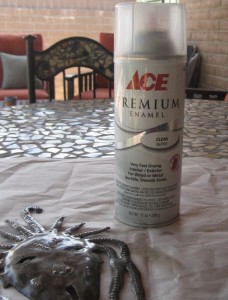
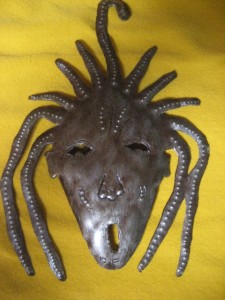 So, not that this would EVER happen to you, but if it did, do not despair. In each case, I waited until the misapplication had dried completely. Then, using first medium-coarse sandpaper and then a fine steel-wool, I removed the black/splotched/excessive coat. Finally, exercising a careful assessment of the cap color, the likelihood of imminent cloudburst, and localized bee activity, I proceed as directed on the label of the can. Quite simple, really.
So, not that this would EVER happen to you, but if it did, do not despair. In each case, I waited until the misapplication had dried completely. Then, using first medium-coarse sandpaper and then a fine steel-wool, I removed the black/splotched/excessive coat. Finally, exercising a careful assessment of the cap color, the likelihood of imminent cloudburst, and localized bee activity, I proceed as directed on the label of the can. Quite simple, really.